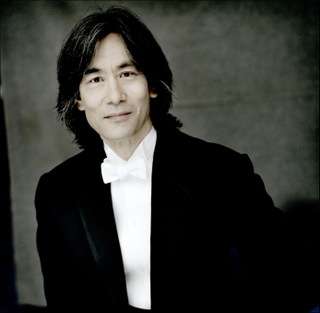|
Back
Mahler’s 2nd Sizzles with Nagano and the OSM Montreal
Maison symphonique de Montréal, Place des Arts
05/09/2012 - & Sept. 6, 8, 2012
Gustav Mahler: Symphony No. 2 in C minor “Resurrection”
Christina Landshamer (Soprano), Anke Vondung (Mezzo-soprano)
OSM Chorus, Andrew Megill (Chorus Master), Orchestre symphonique de Montréal, Kent Nagano (Conductor)

K. Nagano (Courtesy of OSM)
From the strings’ first stabbing fortissimo in Mahler’s Symphony No. 2, one felt from the resulting goose bumps that this was going to be a knock-out performance. And so it was. Kent Nagano and the Orchestre symphonique de Montréal (OSM) pulled out all the stops to open its 2012-13 concert season, the second in their new home, La maison symphonique, situated on the plaza of Place des Arts in downtown Montreal.
From the outset, Nagano established tight control, pulsating rhythm, intensity, a quick pace and courageous drive with the augmented orchestra of 106 musicians that never let up during the first movement. Such was the intensity of Nagano’s interpretation that it seemed to fly by like lightning, despite its 23-minute duration. (The entire symphony clocked in at 84 minutes.) The sound, from where I was sitting in the fourth row of the parterre, was clear, distinct and focused, a quality I’ve sometimes found lacking in other parts of the hall. Details, crescendos and decrescendos as well as dynamic markings in the score were scrupulously respected; fortissimos and fortississimos especially were played as indicated. Mahler would have been satisfied that this “Totenfeier” (funeral rites) movement conjured up the “life, struggles, passions and aspirations” of a well-loved hero. The winds were well prepared, despite a few fuzzy passages, but by the fifth movement they were playing more tightly and with confidence. The two harps were placed on a platform about 20 inches high at the front of stage right, which resulted in profoundly deep sounds that at times, from my seat, almost overwhelmed the rest of the orchestra. Although Mahler asked for a five-minute pause after the first movement for listeners to contemplate what they had just heard, Nagano allowed only two minutes, during which the orchestra retuned.
The second movement, or “Landler” (an Austrian folk dance in three-quarter time), evoked a jolly walk in the countryside and the innocence of lost youth. Nagano brought to the relaxed and bucolic movement extraordinary finish and precision.
The scherzo, based on the “Wunderhorn” song about St. Anthony of Padua’s sermon to the fishes (who like us, ignored the lesson and went on with their lives as before), was rendered with a light, tender touch, which suggested the futility of life. The first flute was excellent and the strings, in their plucked passages, were spot on.
The angelic voice of German mezzo-soprano Anke Vondung (dressed in shocking pink) ushered in the sublime and tranquil “Urlicht” movement with grace and radiance. Her voice was rich, pure, without a trace of vibrato. The young concertmaster, Andrew Wan, played his solos with impassioned intensity. (If only the rest of the violins had followed his lead!)
The tremendous, 34-minute finale could have indeed wakened the dead. With precision and dexterity Nagano negotiated the highly varied episodes of the movement, including the lovingly played brass chorales, the off-stage ensembles and the final resurrection. German soprano Christina Landshamer (in blue-black velvet) sang an evocative “Aufersteh’n, ja aufersteh’n wirst du” (“Rise again, yet thou shalt rise again…”). Like Vondung before her, she was equally controlled and ethereal. The 150-strong chorus, to my astonishment, remained seated until “Sterben werd’ ich, um zu leben …” (“Die I shall so as to live!). Nevertheless, under the adept direction of Andrew Megill, it sang with a single, golden, unified voice.
The evening began with a (thankfully short) welcoming note by the Hon. Lucien Bouchard, former Parti Québecois Prime Minister of Quebec and president of the administrative council of the OSM. He announced, in the presence of Mme Jacqueline Desmarais, a local patron, that she was giving $5,000,000 to pay for the new Casavant pipe organ, which will be inaugurated on May 24, 2014. The organ will be named after Pierre Beique, who is considered the “father” of the OSM. On reflection, it might have been more appropriate to name La maison symphonique after him.
Earl Arthur Love
|